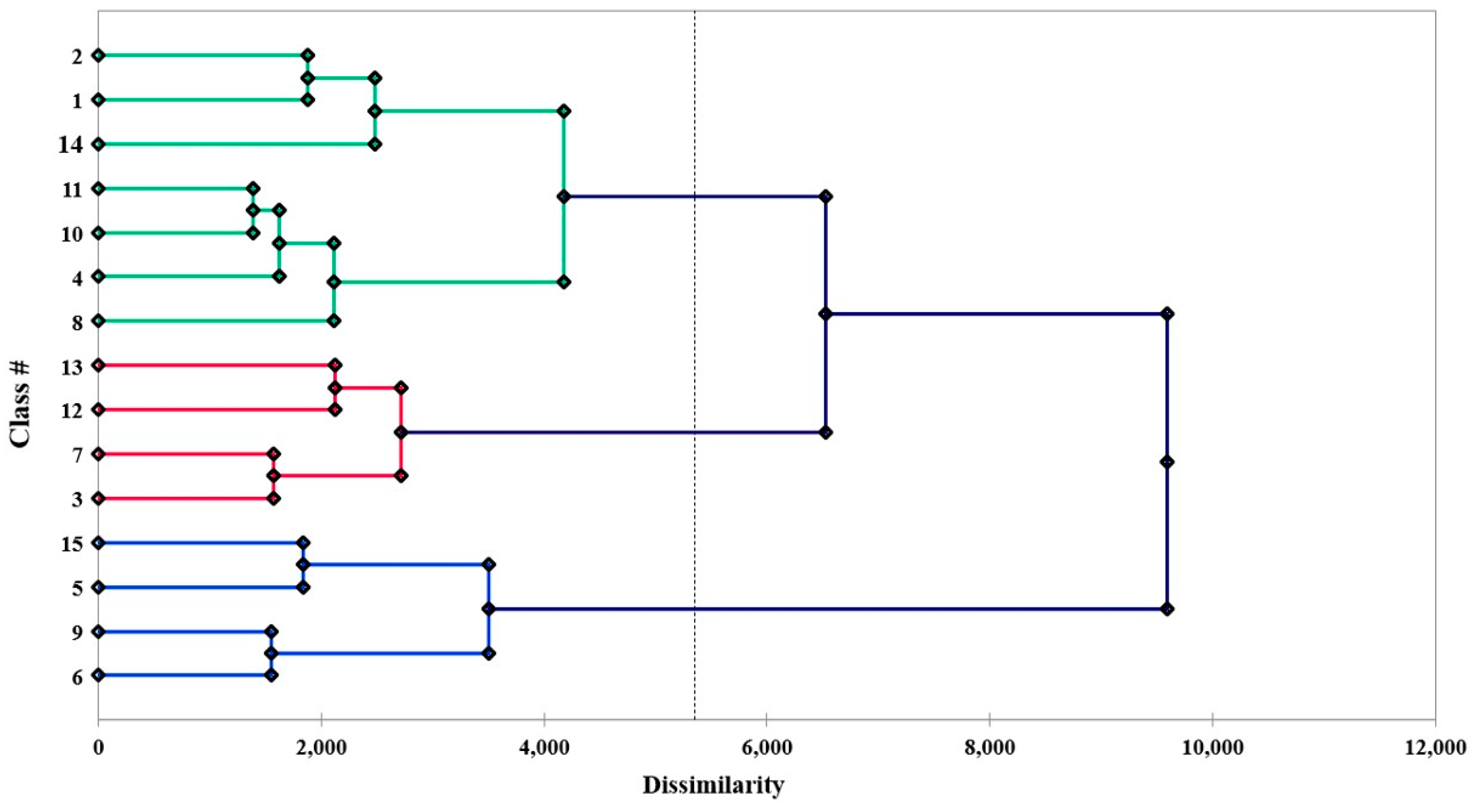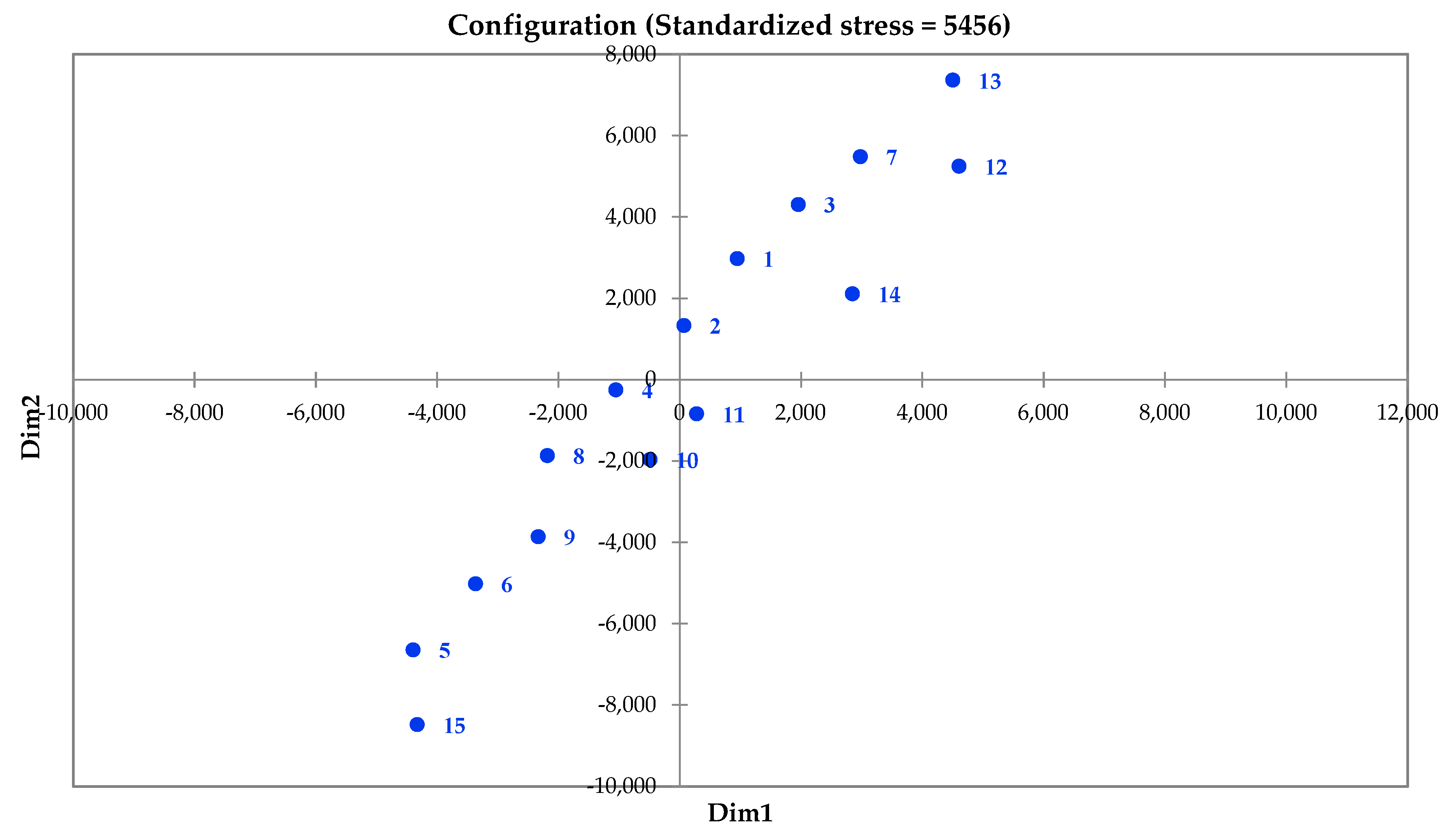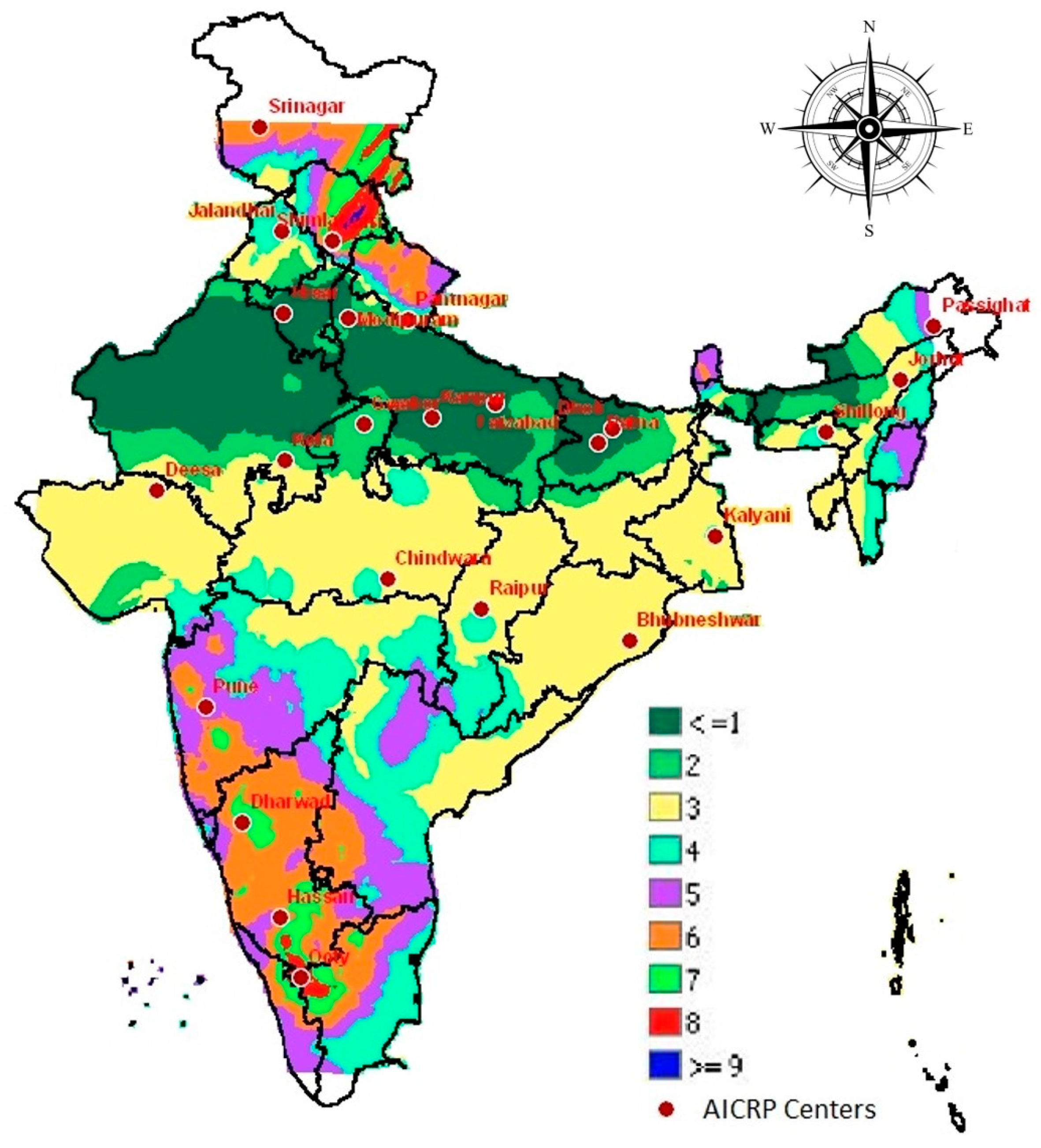Characterizing the Potato Growing Regions in India Using Meteorological Parameters
Abstract
:1. Introduction
2. Materials and Methods
3. Results
4. Discussion
Supplementary Materials
Author Contributions
Funding
Institutional Review Board Statement
Informed Consent Statement
Data Availability Statement
Conflicts of Interest
References
- Pollak, L.M.; Corbett, J.D. Using GIS datasets to classify maize-growing regions in Mexico and central America. Agron. J. 1993, 85, 1133–1139. [Google Scholar] [CrossRef]
- Chenu, K. Characterizing the crop environment—Nature, significance and applications. Crop Physiol. 2015, 321–348. [Google Scholar] [CrossRef]
- Rad, M.N.; Kadir, M.A.; Rafii, M.Y.; Jaafar, H.Z.; Naghavi, M.R.; Ahmadi, F. Genotype environment interaction by AMMI and GGE biplot analysis in three consecutive generations of wheat (Triticum aestivum) under normal and drought stress conditions. Aust. J. Crop Sci. 2013, 7, 956. [Google Scholar]
- Li, Z.; Coffey, L.; Garfin, J.; Miller, N.D.; White, M.R.; Spalding, E.P.; de Leon, N.; Kaeppler, S.M.; Schnable, P.S.; Springer, N.M.; et al. Genotype-by-environment interactions affecting heterosis in maize. PLoS ONE 2018, 13, e0191321. [Google Scholar] [CrossRef] [PubMed] [Green Version]
- Enyew, M.; Feyissa, T.; Geleta, M.; Tesfaye, K.; Hammenhag, C.; Carlsson, A.S. Genotype by environment interaction, correlation, AMMI, GGE biplot and cluster analysis for grain yield and other agronomic traits in sorghum (Sorghum bicolor L. Moench). PLoS ONE 2021, 16, e0258211. [Google Scholar] [CrossRef] [PubMed]
- Silva, R.R.; Riede, C.R.; de Batista Fonseca, I.C.; Zucareli, C.; Benin, G. Investigating suitable test locations and mega-environments for evaluating spring wheat in Brazil. Aust. J. Crop Sci. 2016, 10, 137–143. [Google Scholar]
- Khan, M.M.H.; Rafii, M.Y.; Ramlee, S.I.; Jusoh, M.; Al Mamun, M. AMMI and GGE biplot analysis for yield performance and stability assessment of selected Bambara groundnut (Vigna subterranea L. Verdc.) genotypes under the multi-environmental trails (METs). Sci. Rep. 2021, 11, 1–17. [Google Scholar] [CrossRef]
- Hyman, G.; Hodson, D.; Jones, P. Spatial analysis to support geographic targeting of genotypes to environments. Front. Physiol. 2013, 4, 40. [Google Scholar] [CrossRef] [PubMed] [Green Version]
- Stol, W.; De Koning, G.H.J.; Kooman, P.L.; Haverkort, A.J.; Van Keulen, H.; de Vries, F.P. Agroecological characterization for potato production. In A Simulation Study at the Request of the International Potato Center (CIP); CABO-DLO: Lima, Peru, 1991; p. 155. [Google Scholar]
- Xu, Y. Envirotyping for deciphering environmental impacts on crop plants. Theor. Appl. Genet. 2016, 129, 653–673. [Google Scholar] [CrossRef] [PubMed] [Green Version]
- Hargrove, W.; Hoffman, F. Using multivariate clustering to characterize ecoregion borders. Comput. Sci. Eng. 1999, 1, 18–25. [Google Scholar] [CrossRef] [Green Version]
- Jones, P.G.; Rincón, M.E.; Clavijo, L.A. Area classification and mapping for the Cerrados region of Brasil. CIAT 1992, 94. [Google Scholar]
- Delli, G.; Sarfatti, P.; Bazzani, F.; Cadi, A. Application of GIS for agro-climatological characterization of northern Algeria to define durum wheat production areas. J. Agric. Environ. Int. Develop. 2002, 96, 121–140. [Google Scholar]
- Tonietto, J.; Carbonneau, A. A multicriteria climatic classification system for grape-growing regions worldwide. Agric. For. Meteorol. 2004, 124, 81–97. [Google Scholar] [CrossRef] [Green Version]
- Tonietto, J.; Sotes Ruiz, V.; Zanus, M.C.; Montes, C.; Uliarte, E.M.; Bruno, L.A.; Climaco, P.; Pena, A.; Guerra, C.C.; Ca-tania, C.D.; et al. The effect of viticultural climate on red and white wine typicity-characterization in Ibero-American grape-growing regions. J. Int. Sci. Vigne Vin 2014, 19–23. [Google Scholar]
- Pandey, S.K.; Kang, G.S. Ecological zones and varietal improvement. In The Potato: Production and Utilization in Sub Tropics; Paul Khurana, S.M., Minhas, J.S., Pandey, S.K., Eds.; Mehta Publ: New Delhi, India, 2003; pp. 48–60. [Google Scholar]
- Pradel, W.; Gatto, M.; Hareau, G.; Pandey, S.; Bhardway, V. Adoption of potato varieties and their role for climate change adaptation in India. Clim. Risk Manag. 2019, 23, 114–123. [Google Scholar] [CrossRef] [PubMed]
- Sands, P.; Hackett, C.; Nix, H. A model of the development and bulking of potatoes (Solanum tuberosum L.) I. derivation from well-managed field crops. Field Crop. Res. 1979, 2, 309–331. [Google Scholar] [CrossRef]
- Li, P.H. Potato Physiology; Academic Press: New York, NY, USA, 1985. [Google Scholar]
- Chenu, K.; Cooper, M.; Hammer, G.; Mathews, K.; Dreccer, M.F.; Chapman, S. Environment characterization as an aid to wheat improvement: Interpreting genotype—Environment interactions by modelling water-deficit patterns in north-eastern Australia. J. Exp. Bot. 2011, 62, 1743–1755. [Google Scholar] [CrossRef] [PubMed] [Green Version]
- Li, T.; Ali, J.; Marcaida III, M.; Angeles, O.; Franje, N.J.; Revilleza, J.E.; Manalo, E.; Redoña, E.; Xu, J.; Li, Z. Combining limited multiple environment trials data with crop modeling to identify widely adaptable rice varieties. PLoS ONE 2016, 11, e0164456. [Google Scholar] [CrossRef] [PubMed]
- Teixeira, A.H.D.C.; Tonietto, J.; Pereira, G.E.; Hernandez, F.B.T. Characterization of the wine grape thermohydrological conditions in the tropical Brazilian growing region: Long-term and future assessments. Int. Sch. Res. Not. 2014, 2014, 727123. [Google Scholar] [CrossRef] [Green Version]
- Conceição, M.A.F.; Tonietto, J. Climatic potential for wine grape production in the tropical north region of Minas Gerais State, Brazil. Rev. Bras. Frutic. 2005, 27, 404–407. [Google Scholar] [CrossRef] [Green Version]
- Setimela, P.; Chitalu, Z.; Jonazi, J.; Mambo, A.; Hodson, D.; Banziger, M. Environmental classification of maize-testing sites in the SADC region and its implication for collaborative maize breeding strategies in the subcontinent. Euphytica 2005, 145, 123–132. [Google Scholar] [CrossRef]
- Beillouin, D.; Jeuffroy, M.-H.; Gauffreteau, A. Characterization of spatial and temporal combinations of climatic factors affecting yields: An empirical model applied to the French barley belt. Agric. For. Meteorol. 2018, 262, 402–411. [Google Scholar] [CrossRef]
- Kooman, P.L.; Haverkort, A.J. Modelling development and growth of the potato crop influenced by temperature and daylength: Lintul-potato. In Potato Ecology and Modelling of Crops under Conditions Limiting Growth; Haverkort, A.J., MacKerron, D.K.L., Eds.; Springer: Dordrecht, The Netherlands, 1995; pp. 41–59. [Google Scholar]
- Kumar, S.N.; Govindakrishnan, P.; Swarooparani, D.; Nitin, C.; Surabhi, J.; Aggarwal, P. Assessment of impact of climate change on potato and potential adaptation gains in the indo-gangetic plains of India. Int. J. Plant Prod. 2015, 9, 151–170. [Google Scholar] [CrossRef]
- Pushkarnath. Potato in Sub-Tropics; Orient Longman: New Delhi, India, 1976; p. 289. [Google Scholar]
- Worthington, C.M.; Hutchinson, C.M. December. Accumulated growing degree days as a model to determine key developmental stages and evaluate yield and quality of potato in Northeast Florida. Proc. Fla. State Hortic. Soc. 2005, 118, 98–101. [Google Scholar]
- Hoover, M.W. Some effects of temperature on the growth of southern peas. Proc. Am. Soc. Hortic. Sci. 1955, 66, 308–312. [Google Scholar]
- Dufault, R.J. Determining heat unit requirements for broccoli harvest in coastal south Carolina. J. Am. Soc. Hortic. Sci. 1997, 122, 169–174. [Google Scholar] [CrossRef]
- Perry, K.B.; Wehner, T.C.; Johnson, G.L. Comparison of 14 methods to determine heat unit requirements for cucumber harvest. HortScience 1986, 21, 419–423. [Google Scholar] [CrossRef]
- Connell, T.R.; Binning, L.K.; Schmitt, W.G. A canopy development model for potatoes. Am. J. Potato Res. 1999, 76, 153–159. [Google Scholar] [CrossRef]
- Shtienberg, D.; Bergeron, S.N.; Nicholson, A.G.; Fry, W.E.; Ewing, E.E. Development and evaluation of a general model for yield loss assessment in potatoes. Phytopathology 1990, 80, 466–472. [Google Scholar] [CrossRef]
- Ghahreman, N.; Varshaviana, V.; Javan-Nikkhahb, M.; Liaghata, A. Forecasting of potato early blight disease using different sets of meteorological data. Can. J. Basic Appl. Sci. 2015, 3, 59–66. [Google Scholar]
- Monteith, J.L. Climate and the effificiency of crop production in Britain. Philos. Trans. R. Soc. Lond. B 1977, 281, 277–294. [Google Scholar]
- Singh, B.P.; Dua, V.K.; Govindakrishnan, P.M.; Sharma, S. Impact of climate change on potato. In Climate-Resilient Horticulture: Adaptation and Mitigation Strategies; Springer: New Delhi, India, 2013; pp. 125–135. [Google Scholar]
- Quiroz, R.; Ramírez, D.A.; Kroschel, J.; Andrade-Piedra, J.; Barreda, C.; Condori, B.; Mares, V.; Monneveux, P.; Perez, W. Impact of climate change on the potato crop and biodiversity in its center of origin. Open Agric. 2018, 3, 273–283. [Google Scholar] [CrossRef]
- Singh, B.; Kukreja, S.; Goutam, U. Impact of heat stress on potato (Solanum tuberosum L.): Present scenario and future opportunities. J. Hortic. Sci. Biotechnol. 2020, 95, 407–424. [Google Scholar] [CrossRef]




| Class | Number of Locations | Meteorological Variables | |||||
|---|---|---|---|---|---|---|---|
| Altitude (m) | Physiological Days | Growing Degree Days | Mean Night Temperature (°C) | Mean Total Temperature (°C) | Mean Radiation (KJ/day/m2) | ||
| 1 | 399 | 211.2 (2.0–1359.0) | 849.0 (469.8–1065.2) | 1749.0 (1124.0–2637.9) | 15.5 (12.7–22.7) | 19.2 (16.3–26.0) | 18,684.1 (17,136.7–19,424.2) |
| 2 | 45 | 567.2 (4.0–1729.0) | 813.6 (467.0–1042.3) | 1641.4 (1025.1–2300.6) | 15.9 (12.5–21.4) | 18.6 (15.8–23.5) | 16,720.4 (15,471.8–17,775.0) |
| 3 | 540 | 279.2 (4.0–1407.0) | 798.3 (355.2–1050.4) | 1856.6 (939.2–2383.8) | 17.8 (12.8–24.3) | 21.6 (16.9–25.1) | 20,287.6 (19,184.8–21,441.1) |
| 4 | 23 | 374.3 (182.0–900.0) | 671.3 (488.5–928.7) | 1546.8 (1282.7–1781.1) | 17.8 (14.7–21.2) | 21.0 (14.3–23.2) | 14,755.5 (13,845.3–15,501.4) |
| 5 | 17 | 1036.3 (181.0–2311.0) | 1046.1 (748.2–1127.0) | 1806.8 (1316.2–1999.4) | 17.9 (13.3–19.3) | 18.9 (11.0–20.7) | 7594.6 (6539.2–8346.7) |
| 6 | 12 | 1125.7 (282.0–2145.0) | 940.3 (549.7–1121.2) | 1718.5 (1123.1–2091.2) | 17.0 (13.3–20.0) | 19.9 (14.92–21.46) | 9520.4 (8947.5–10,221.7) |
| 7 | 166 | 517.5 (6.0–1100.0) | 704.6 (352.9–1027.5) | 1802.3 (984.4–2368.6) | 19.8 (14.4–22.4) | 23.3 (17.5–25.9) | 21,832.8 (10,929.2–23,222.8) |
| 8 | 15 | 315.6 (9.0–782.0) | 841.6 (410.0–1090.9) | 1748.6 (823.2–2151.2) | 18.0 (14.7–21.4) | 19.6 (11.7–23.0) | 12,912.4 (12,018.6–13,683.1) |
| 9 | 16 | 1207.1 (247.0–1928.0) | 929.3 (718.9–1108.6) | 1711.9 (1190.0–2142.6) | 16.6 (11.3–20.8) | 17.8 (10.8–22.5) | 11,257.6 (10,301.7–12,533.3) |
| 10 | 7 | 1535.1 (1183.0–1821.0) | 756.8 (545.6–971.0) | 1404.7 (1036.4–1594.8) | 14.8 (12.0–18.1) | 17.6 (15.3–21.8) | 13,709.4 (12,997.5–14,179.16) |
| 11 | 3 | 1946.0 (1689.0–2127.0) | 907.4 (853.4–941.4) | 1699.4 (1489.7–1918.0) | 16.1 (15.2–17.3) | 18.5 (17.5–20.0) | 15,189.0 (14,908.3–15,527.9) |
| 12 | 1 | 1959.0 | 836.6 | 1341.8 | 12.7 | 15.2 | 22,594.2 |
| 13 | 5 | 605.8 (233.0–790.0) | 709.2 (505.3–1116.5) | 1715.5 (1482.4–2353.8) | 18.8 (13.2–20.4) | 22.8 (17.9–24.3) | 24,443.3 (24,055.1–24,968.0) |
| 14 | 2 | 2158.0 (2079.0–2237.0) | 895.0 (871.7–918.3) | 1485.9 (1426.9–1544.9) | 13.7 (13.3–14.2) | 16.4 (15.9–16.9) | 19,208.8 (19,005.0–19,412.5) |
| 15 | 2 | 1962.5 (1941.0–1984.0) | 895.3 (851.6–938.9) | 1736.6 (1487.3–1986.6) | 15.7 (13.9–17.5) | 9.4 (7.3–11.4) | 5652.1 (5084.4–6219.9) |
| Max | 2311.0 | 1127.0 | 2637.9 | 24.3 | 26.0 | 24,968.0 | |
| Min | 2.0 | 352.9 | 823.2 | 11.3 | 7.3 | 5084.4 | |
| Average | 351. 3 | 807.2 | 1792.8 | 17.2 | 20.8 | 19,226.0 | |
| Standard deviation | 343.1 | 155.5 | 306.1 | 2.2 | 2.2 | 2649.5 | |
| Class No. | Number of AICRP (P) Centres in the Specific Class | All India Coordinated Research Project (Potato) | |
|---|---|---|---|
| Name of the AICRP (P) Centres # | Number of Locations in the Class | ||
| 1 | 7 | Patna (25.59°; 85.13°), Meerut (28.98°; 77.70°), Faizabad (26.77°, 82.14°), Hassan (13.01°; 76.10°), Hisar (29.15°; 75.72°), Kanpur (26.45°; 80.33°) and Kota (25.21°; 75.86°) | 399 |
| 2 | - | - | 45 |
| 3 | 4 | Bhubaneshwar (20.29°; 85.82°), Deesa (24.26°; 72.19°), Gwalior (26.22°; 78.18°) and Raipur (21.25°; 81.62°) | 540 |
| 4 | - | Shillong (25.57°; 91.89°) | 23 |
| 5 | 1 | Shimla (31.10°; 77.17°) | 17 |
| 6 | 1 | - | 12 |
| 7 | 2 | Dharwar (15.46°; 75.01°) and Pune (18.52°; 73.85°) | 166 |
| 8 | 4 | Jorhat (26.75°; 94.20°), Kalyani (22.98°; 88.43°), Pantnagar (29.02°; 79.49°) and Pasighat (28.06°; 95.32°) | 15 |
| 9 | - | - | 16 |
| 10 | 1 | Srinagar (J & K) (34.08°; 74.80°) | 7 |
| 11 | 1 | Ranichauri/Pauri (30.14°; 78.77°) | 3 |
| 12 | - | - | 1 |
| 13 | 1 | Jalandhar (31.33°; 75.58°) | 5 |
| 14 | 1 | Ootacamund (11.40°; 76.69°) | 2 |
| 15 | - | - | 2 |
| Total | 1253 | ||
Publisher’s Note: MDPI stays neutral with regard to jurisdictional claims in published maps and institutional affiliations. |
© 2022 by the authors. Licensee MDPI, Basel, Switzerland. This article is an open access article distributed under the terms and conditions of the Creative Commons Attribution (CC BY) license (https://creativecommons.org/licenses/by/4.0/).
Share and Cite
Bhardwaj, V.; Rawat, S.; Tiwari, J.; Sood, S.; Dua, V.K.; Singh, B.; Lal, M.; Mangal, V.; Govindakrishnan, P. Characterizing the Potato Growing Regions in India Using Meteorological Parameters. Life 2022, 12, 1619. https://doi.org/10.3390/life12101619
Bhardwaj V, Rawat S, Tiwari J, Sood S, Dua VK, Singh B, Lal M, Mangal V, Govindakrishnan P. Characterizing the Potato Growing Regions in India Using Meteorological Parameters. Life. 2022; 12(10):1619. https://doi.org/10.3390/life12101619
Chicago/Turabian StyleBhardwaj, Vinay, Shashi Rawat, Jagesh Tiwari, Salej Sood, Vijay Kumar Dua, Baljeet Singh, Mehi Lal, Vikas Mangal, and PM Govindakrishnan. 2022. "Characterizing the Potato Growing Regions in India Using Meteorological Parameters" Life 12, no. 10: 1619. https://doi.org/10.3390/life12101619
APA StyleBhardwaj, V., Rawat, S., Tiwari, J., Sood, S., Dua, V. K., Singh, B., Lal, M., Mangal, V., & Govindakrishnan, P. (2022). Characterizing the Potato Growing Regions in India Using Meteorological Parameters. Life, 12(10), 1619. https://doi.org/10.3390/life12101619








